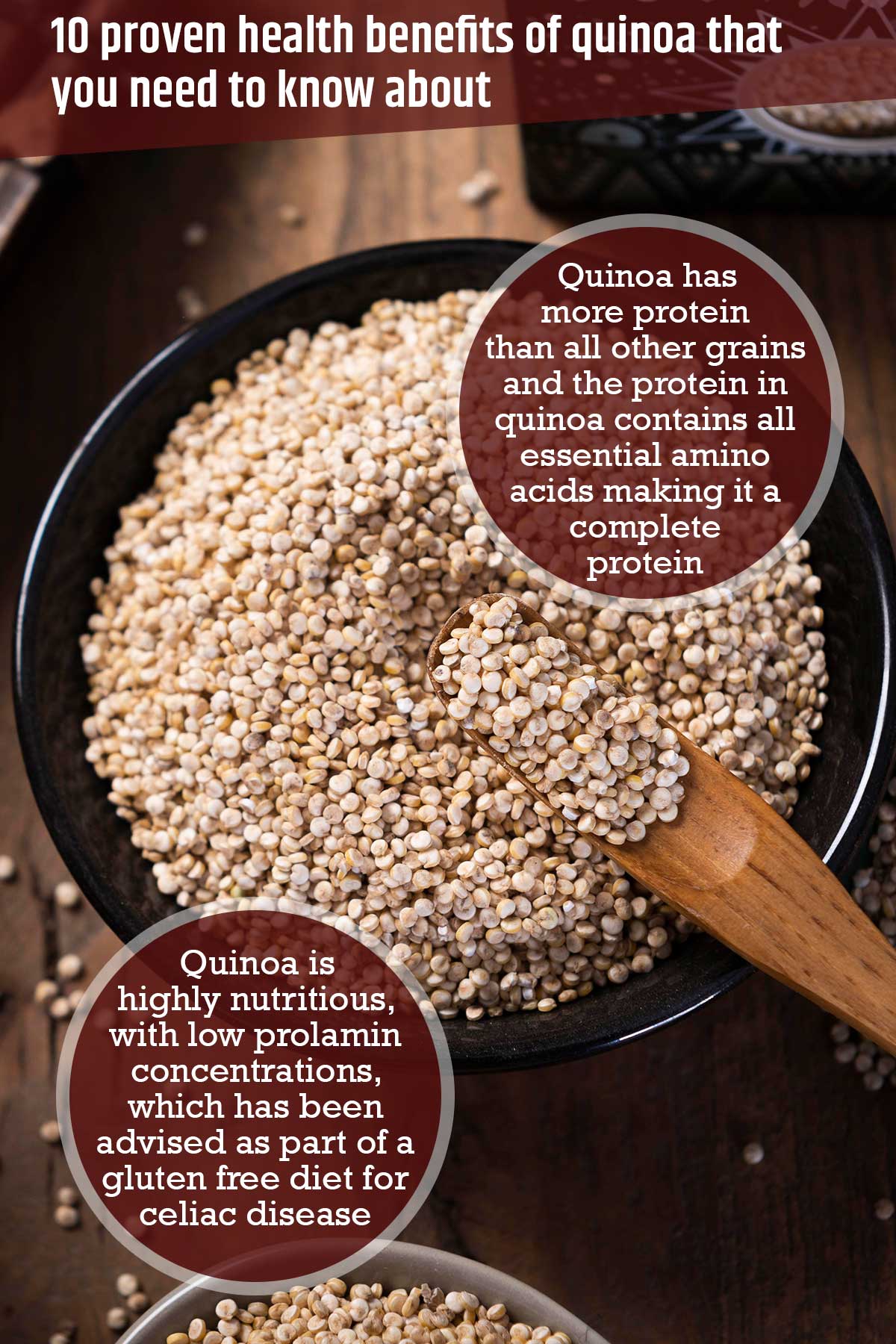Nutrients in quinoa
Quinoa is a great source of manganese and magnesium. It’s a very good source of protein source as well as vitamins E and B2, and dietary fiber. It’s a good source of iron, copper, phosphorus and zinc.
Quinoa has been considered as a crop for NASA’s Controlled Ecological Life Support System due to its high protein values and unique composition of amino acids.
One serving of quinoa has the following amino acids: leucine, isoleucine, lysine, tyrosine, phenylalanine, methionine, cysteine, histidine, threonine, tryptophan and valine.
The exact amounts of these amino acids varies slightly, but a serving of quinoa always has significant amounts of each.
Amino acids are the building blocks of protein. Our bodies require amino acids to make structural proteins as well as produce hormones and neurotransmitters.
Although our bodies use a multitude of amino acids, we only need nine essential amino acids in our diet.
Nutritional value of quinoa per 100g (cooked):
- How many calories in quinoa – 120
- How much protein in quinoa – 4.4g
- How many carbs in quinoa – 21g
- What is the fat content of quinoa – 1.9g
1 – Is quinoa fattening?
Quinoa has more protein than all other grains and the protein in quinoa contains all essential amino acids making it a complete protein. Protein intake can increase metabolism and help reduce appetite.1✅ JOURNAL REFERENCE
PMID: 18448177 According to a study, in comparison to wheat and rice, quinoa was found to provide greater satiety, making it an excellent alternative for weight loss and management.2✅ JOURNAL REFERENCE
PMID: 16277791
2 – Is quinoa gluten free?
Quinoa is an important source of nutrients for individuals having celiac disease. Celiac disease is brought on by dietary gluten present in wheat, rye and barley. A strict gluten free diet is the current treatment for celiac disease.3✅ JOURNAL REFERENCE
PMID: 19519750
Quinoa is highly nutritious, with low prolamin concentrations, which has been advised as part of a gluten free diet for celiac disease.
3 – Is quinoa good for diabetes?
The antioxidant activity of the quercetin in quinoa has the ability to reduce sorbitol levels. Sorbitol is a sugar which accumulates in kidney cells, nerve cells, and cells in the eyes of type 2 diabetes patients.
4 – Is quinoa good for cholesterol?
Research has shown that quinoa lowers total cholesterol and helps maintain HDL cholesterol levels.
5 – Is quinoa good for cancer?
Scientists have found quinoa to be especially rich in an antioxidant known as quercetin, even higher than other high quercetin foods such as cranberries. Quercetin has been shown to have anti-cancer properties.4✅ JOURNAL REFERENCE
PMID: 18467024
6 – Is quinoa good for migraines?
Quinoa is high in magnesium and vitamin B2 (riboflavin). Magnesium helps to alleviate migraines by relaxing blood vessels. Vitamin B2 helps to reduce migraine by promoting the expansion of blood vessels in the brain.
7 – Is quinoa good for digestion?
Quinoa has almost twice the amount of dietary fiber compared to most other grains. Dietary fiber promotes healthy digestion and is known to relieve constipation.
8 – Is quinoa good for cardiovascular health?
Research has associated quinoa rich diets with a reduced risk of developing cardiovascular conditions like stroke and heart disease.
9 – Is quinoa good for the muscles?
Quinoa is an excellent source of more protein which contains all essential amino acids, including the amino acid lysine, essential for tissue growth and repair. Lysine is usually found in sports supplements used for muscle growth. Quinoa is also high in manganese, an antioxidant that helps in preventing damage of mitochondria during energy production.
10 – Is quinoa good for the blood?
Quinoa is a great source of plant based iron, which helps to keep the red blood cells healthy.
History of quinoa
Quinoa was for the South American Native Americans a dietary staple. A mixture of fat and quinoa known as “war balls” was used to sustain the Incan armies that usually marched days at a time. In an effort to wipe out the South American natives as well as their culture, the Spanish conquistadors just about eradicated the existence of quinoa.
The majority of quinoa is brought in from South American countries like Bolivia, Peru and Ecuador, though it’s also being grown in the Colorado Rockies in the U.S.
Media stories published in the last few years have discouraged some people from buying imported quinoa, but the idea that worldwide demand for quinoa is resulting in the local population unable to afford it is a gross oversimplification. Instead of helping, discouraging demand for quinoa could threaten to harm a most promising industry in one of the world’s poorest places.



